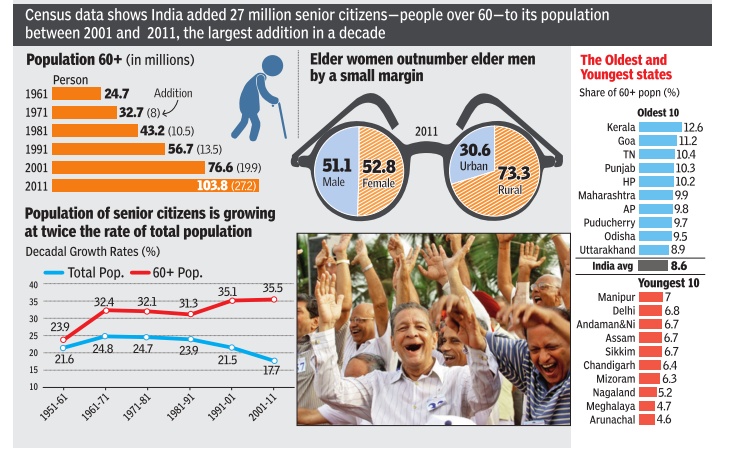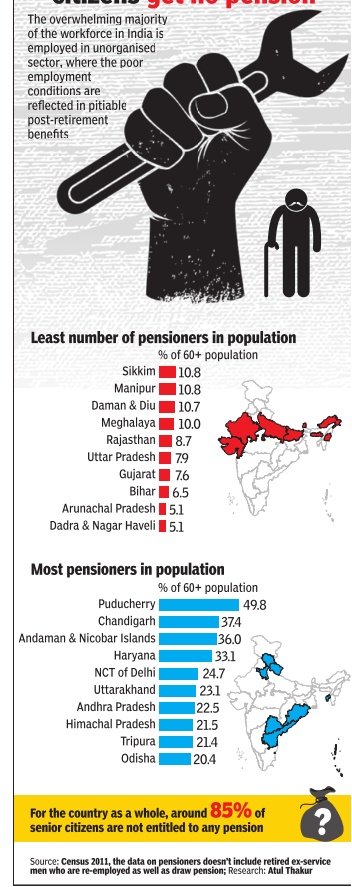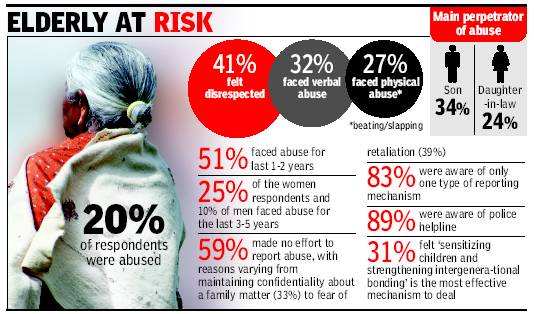Senior citizens/ Elders: India
m (Jyoti moved page Elder Abuse: India to Elders/ Senior citizens: India without leaving a redirect) |
|||
| Line 34: | Line 34: | ||
Prominent jurist and India’s first woman judge, Leila Seth (82) also addressed the elders about the importance of not transferring property ownership before death. “I had thought of transferring the house in my daughter’s name. But a close lawyer friend had advised me not to do so. Today most elderly are abused because of property related issues,” Seth said. | Prominent jurist and India’s first woman judge, Leila Seth (82) also addressed the elders about the importance of not transferring property ownership before death. “I had thought of transferring the house in my daughter’s name. But a close lawyer friend had advised me not to do so. Today most elderly are abused because of property related issues,” Seth said. | ||
| + | |||
| + | =Confinement of elders to home= | ||
| + | [http://epaperbeta.timesofindia.com/Article.aspx?eid=31808&articlexml=34-of-80-yr-olds-in-villages-and-18042016010029 ''The Times of India''], Apr 18 2016 | ||
| + | |||
| + | ''' 34% of 80-yr-olds in villages and 27% in cities confined to homes ''' | ||
| + | |||
| + | Mahendra Singh | ||
| + | |||
| + | About 8.4% of people aged 60 and above in villages and 7% in cities and towns are either confined to their home or bed and the incidence is higher for women , a government health survey has found. | ||
| + | The survey underlines the dependency of older people on assistance and limitations on their mobility as the percentage of home-bound elders rises to 27% in urban and 34% in rural areas in the 80-plus age group. | ||
| + | |||
| + | The ability to get around is an important indicator of the physical condition and overall health of older persons. A large proportion of the elderly are also economically dependent on others for their livelihood. The NSSO survey found that around 52% of the aged in rural and 51% in urban had to depend on others for their day-to-day needs. | ||
| + | |||
| + | The dependence was very high for elderly women. About 90% of aged women in rural and 87% in urban areas were economically dependent either partially or fully . The problem points to the possibility that many were not formally employed and lacked retirement planning or even options. It was found that 43% of men in rural and 52% in urban areas were economically independent in terms of their livelihoods. | ||
| + | |||
| + | Most of the economically dependent aged people -82% in rural and 80% in urban areas -depended on their children for financial support while a sizeable proportion (11% in rural and 15% in urban areas) depended on spouses. A small proportion -5% in urban and 7% in rural areas -were supported by their grandchildren or `others' which includes non-relatives. | ||
| + | |||
| + | The survey found very few elderly lived alone in India. The figure was only 4% in both rural and urban areas. About 61% of the aged in rural and 63% in urban areas lived with spouses. Some 35% in rural and 33% in urban areas lived without spouses but with children or other relatives. The survey found that the percentage of elderly was 7.7% in rural areas and 8.1% in urban areas. | ||
| + | |||
| + | The sex-ratio among aged persons of 60 years and more was 1035 in rural India and 1029 in urban areas, indicating a higher life expectancy for women. | ||
Revision as of 19:13, 29 November 2016


This is a collection of newspaper articles selected for the excellence of their content. |
Problems with children
The Times of India 2013/06/15
Elderly have much to fear from their children TIMES NEWS NETWORK
New Delhi: Almost one-fifth of elders surveyed in Delhi have complained of abuse, says the latest data released by an NGO. The capital has the third highest rate of abuse after Hyderabad and Kolkata among five Tier-I cities that were surveyed.
TheHelpAgeIndia report‘Elder Abuse in India 2013’ that has covered 6,748 elders across 24 cities also found another unique trend in Delhi. While nationally, thedaughter-in-lawwasfoundto be the primary perpetrator of abuse, in Delhi it was the son followed by daughter-in-law. More than one fifth of the total respondents nationally said that they had faced abuse by caregivers or family members.
The nature of abuse ranged from disrespect to severe physical abuse. B R Sahni (82) for instance who attended the report launch was one of the thousands who complained to being beaten and slapped by his son.
“This report reveals the reality of elders in India. I moved to an old age home 4 years ago after being physically abused by my children. They said they couldn’t bear the costs of taking care of me. But I am very happy today at the ashram where I live. Not all elders get a shelter like I have,” he said.
Nationally, the highest number of abuse cases were seen in Madurai (63%) followed by Kanpur (60%). Among those who were abused over 16% from Rajasthan and 13% from Andhra Pradeshsaidthey were physically abused. Among Tier- II cities that were covered, Chennai had the lowest (9.64%) and Hyderabad had the highest (37.50%) cases of abuse.
The major reasons cited by the elderly for abuse were ‘lack of adjustment,’ ‘economic dependence of the abused,’ ‘increasing longevity’ and even ‘economic dependence of abuser.’ Most of the respondents (70%) did not report the abuse. Most felt that such family matters should be felt confidential and many feared retaliation.
Prominent jurist and India’s first woman judge, Leila Seth (82) also addressed the elders about the importance of not transferring property ownership before death. “I had thought of transferring the house in my daughter’s name. But a close lawyer friend had advised me not to do so. Today most elderly are abused because of property related issues,” Seth said.
Confinement of elders to home
The Times of India, Apr 18 2016
34% of 80-yr-olds in villages and 27% in cities confined to homes
Mahendra Singh
About 8.4% of people aged 60 and above in villages and 7% in cities and towns are either confined to their home or bed and the incidence is higher for women , a government health survey has found. The survey underlines the dependency of older people on assistance and limitations on their mobility as the percentage of home-bound elders rises to 27% in urban and 34% in rural areas in the 80-plus age group.
The ability to get around is an important indicator of the physical condition and overall health of older persons. A large proportion of the elderly are also economically dependent on others for their livelihood. The NSSO survey found that around 52% of the aged in rural and 51% in urban had to depend on others for their day-to-day needs.
The dependence was very high for elderly women. About 90% of aged women in rural and 87% in urban areas were economically dependent either partially or fully . The problem points to the possibility that many were not formally employed and lacked retirement planning or even options. It was found that 43% of men in rural and 52% in urban areas were economically independent in terms of their livelihoods.
Most of the economically dependent aged people -82% in rural and 80% in urban areas -depended on their children for financial support while a sizeable proportion (11% in rural and 15% in urban areas) depended on spouses. A small proportion -5% in urban and 7% in rural areas -were supported by their grandchildren or `others' which includes non-relatives.
The survey found very few elderly lived alone in India. The figure was only 4% in both rural and urban areas. About 61% of the aged in rural and 63% in urban areas lived with spouses. Some 35% in rural and 33% in urban areas lived without spouses but with children or other relatives. The survey found that the percentage of elderly was 7.7% in rural areas and 8.1% in urban areas.
The sex-ratio among aged persons of 60 years and more was 1035 in rural India and 1029 in urban areas, indicating a higher life expectancy for women.
